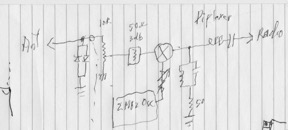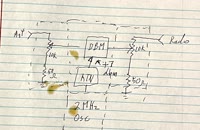back to offset attenuators
NK0T attenuator
NK0T attenuator:
Curt Wilson (NK0T) is a local here that is trying a new approach to offset attenuators, to address the problem
of the "donut of no bearing" that offset attenuators often have.
This is a problem I've personally ran into with every offset attenuator I've tried. The issue the OA's try to
solve is pretty simple - when you get too close to a transmitter with something like a tape-measure beam, you
can only get so close before your radio is reading full-scale no matter what direction you point your beam or
other directional antenna. This creates a circle around the transmitter that you can't use your beam inside.
All you can do with it is to get bearings from outside the circle, and (visually or with a map) "draw lines"
of bearings and try to figure out approximately where the transmitter is. This works okay-ish for low power
foxes in small hunts, because all bearings may point to an easy landmark like a tree stump or a shack or a
pile of sticks etc. From there you just hae to set down your radio and try to physically identify the fox.
The offset attenuator tries to solve this problem by mixing the received signal externally (just after the
antenna) by some fixed frequency (usually 2 or 4 mhz) so that you can tune your radio to that "offset" freq
and track that instead. Directional antennas still work, and since your radio is tuned to a different freq
than the fox, you can get extremely close to it without the signal just plain bypassing your antenna and
getting directly into the IF stages of your radio. IN THEORY this also allows for "infinite attenuation',
because the strength of the offset frequency into your radio is no longer JUST a matter of how close you are
to the fox, but ALSO can be controlled by varying the amount of signal you mix into it. If your mix is very
small, the offset signal will be very small into your radio even when you're just a few feet away from the fox.
ALl this of course assumes your offset attenuator uses good internal isolation (most don't) and you're not
having problems with "air mixing". This prevents your attenuator from actually achieving "infinite attenuation"
(unless you just turn off the power) so you will have some maximum possible attenuation, even with the mix set
as low as possible. Therefore, most offset attenuators will max out at between 60 and 80 db attenuation.
So at very short (but not EXTREMELY short) distances, the offset attenuator works very well. But it has a
limited range. The problem comes up when you're some distance from the fox, so the fox signal isn't as strong.
The mixing methods used in ALL of the offset attenuators I've tried uses a simple single-diode mixing method,
which isn't very sensitive. This is fine when you're close, but you don't have to get too far away before sensitivity
becomes a problem and you can't hear the fox anymore on the offset frequency, even with maximum mixing.
So this creates a second circle on the map, again centered on the fox, outside which you CANNOT use the offset
attenuator, because the fox's signal just isn't strong enough. And here's where the problem is - the circle
you can't be INSIDE when receiving directly (due to overload) is BIGGER than the circle that you can't be
OUTSIDE for the offset attenuator to work. (due to weak signal) This creates a "donut" shaped area around
the fox where both direct receive and offset attenuation cannot be used. If you get farther from the fox, you
can switch to direct receive, and if you get closer to the fox you can switch to your offset attenuator, but
inside this donut you can't get any bearings.
The size of the donut varies, but for larger hunts for more powerful transmitters, it becomes a bigger problem,
because the depth of the donut gets wider. To get "inside the donut" where you can use your offset attenuator,
you just need to use bearings from direct receive and draw lines on a map and go closer to where the lines are
meeting, but that's not always convenient, and it costs you time. In a hunt where you're competing against
others to get to the fox first, it can be a serious problem that drops you back a place or two in a round.
There is also the question of if your OA will actually generate interference with other hunters' radios. The
issue with many designs is they do the mix right at the antenna input, and thus are radiating the mixed signal
out your antenna, as well as radiating the frequency of the mix. (this could be a serious problem for another
hunter that's also using an OA with the same mix frequency, because they could be getting a bearing on YOU)
Curt's design incorporates several improvements on the basic OA design:
- has a diode suppressor on the input to block extremely strong signals
- add a notch filter on the antenna input that sharply attenuates any mix frequency, to prevent leakage
- adds a control to adjust received signal into the attenuator
- uses a double-balanced mixer to cleanly mix a fixed frequency with the received signal
- both the input and the output of the mixer will be impedance-adjusted to 50 ohms
- the fixed frequency will be generated and adjustably attenuated in a separate, heavily shielded compartment
This should create several improvements. No 2mhz signal leaking out the antenna, greater sensitivity than a
diode mixer, higher mix signal isolation to prevent air-mixing, and balanced inputs/outputs to further improve
sensitivity. The goal here is to move the inner ring out PAST the outer ring, such that the offset attenuator
can begin to be used even before the direct-received signal has started to pin the meter on the radio.
2023.08.12 doodle:

2024.04.13 DBM schematic:

highest resolution images
last updated 06/14/2024 at 19:12:51 by make_www_index.command version 2024.05.25.A
